|
September 1935 Short Wave Craft
 [Table of Contents] [Table of Contents]
Wax nostalgic about and learn from the history of early electronics. See articles
from Short Wave Craft,
published 1930 - 1936. All copyrights hereby acknowledged.
|
Here for radio hobbyists
are a dozen handy-dandy "kinks," otherwise known as tricks, shortcuts, or clever
ideas, that could prove useful while working in the lab at work or in your shop
at home. They appeared in the September 1935 issue of Short Wave Craft
magazine, thus, some seem a tad outdated. One kink that might be worth trying calls
for immersing an aluminum panel in a water-lye solution to achieve "a professional-looking
finish." A satin look results. A Google search on etching aluminum turns up many
other methods. Admittedly, most of these ideas would not have much application with
today's ready-made radios, antennas, power supplies, etc., but there are still people
who build custom equipment and/or repair circuits.
$5.00 for Best Short Wave Kink
The Editor will award a five dollar prize each month for the best short-wave
kink submitted by our readers. All other kinks accepted and published will be awarded
eight months subscription to Short Wave Craft. Look over these "kinks" and they
will give you some idea of what the editors are looking for. Send a typewritten
or ink description, with sketch, of your favorite short-wave kink to the "Kink"
Editor, Short Wave Craft.
 Antenna Condenser Switch Antenna Condenser Switch
$5.00 Prize
The short-wave experimenters who build simple receivers which require the use
of an antenna-coupling condenser will find this kink especially valuable. It consists
of a small strip of bakelite or other insulating material on which is mounted four
antenna-coupling condensers. The drawing clearly shows how these plates should be
made in order to be adjustable. There is a separate condenser for each short-wave
band and when putting it into operation each condenser should be adjusted for that
particular band. Then when you change from one band to another it is only necessary
to rotate the switch and bring the antenna condenser tor that band into use. Charles
Dopita.
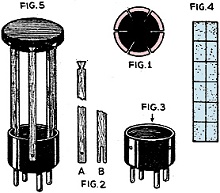 Plug-In Coil Form Plug-In Coil Form
Good plug-in coil forms can be made using old tube bases. Gut a strip of paper
the circumference of the tube base and use a compass or dividers to divide it into
six equal parts (Fig. 4). Wrap this around the base and drill shallow holes
in the base, on the division lines, with a knife point. Finish drilling the holes
with a 1/16-inch drill. (Fig. 3.)
The top of the coil form is made of wood. A circle is cut from a three-eighths
or one-half-inch board. Make the top one-half inch larger in diameter than the tube
base. Draw a circle on the underneath side of the top one quarter of an inch smaller
than its diameter. This is the guide line for adjusting the upper ends or the upright
pieces. Divide the top into six equal parts and cut the notches for the upper ends
of the upright pieces, on the dividing lines. The shape of the notches can be seen
by looking at the finished coil form. (Fig. 5.)
The upright pieces may be made of wood, hard rubber or bakelite. Cigar-box wood
is easy to work and makes good coil forms. The lower end is slotted to fit over
the tube base. (Fig. 2B. ) - Earl Ewens.
 Voltage Booster Voltage Booster
The A.C. line voltage. particularly in rural communities, sometimes drops to
a low value during the evening hours. An easy and simple way to boost it to its
proper value is to use a small transformer, with a secondary rating of between 5
and 15 volts, connected as shown.
It may be necessary to reverse the leads to the secondary to get the proper relation
between primary and secondary windings. - George Jelinek.
 Finishing Aluminum Panels Finishing Aluminum Panels
It is now possible for the amateur set builder to put a professional-like finish
on his aluminum panels.
Simply make a solution consisting of one can of household lye to one gallon of
water. Put this into a cheap tin baking pan. It should be large enough to hold the
panel when it is resting on four supports, which are used to keep it from touching
the sides or the pan. These supports can be small stones, or anything of like nature.
The panel should first be thoroughly washed and then placed "face up" in the pan,
being sure that it is covered with the solution. The usual time required is from
ten to thirty minutes, the larger the panel, the longer the time required to finish
it. - Jim Hosking
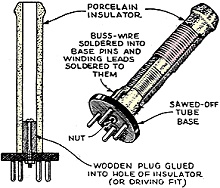 Insulating Tube Coil Form Insulating Tube Coil Form
I have found a convenient method of using old lead-in insulators and old tube
bases for a very compact and efficient coil form. A bolt is cemented in the small
end of the insulator with porcelain cement or regular household cement.
Then a 1/8" hole is drilled through the center of the tube base for the bolt
to pass through, and the tube base is bolted on with this arrangement. This coil
works fairly well and is very compact. Also, the knob on the insulator acts as a
good handle. - Bud Naratta.
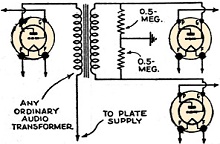 Push-Pull Input Transformer Push-Pull Input Transformer
Set builders desiring to use push-pull in the output stage can save the cost
of an "input" push-pull transformer by wiring it in accordance with the accompanying
diagram. Any standard audio transformer can be used, and gives tone quality equal
to that obtained by using a regular push-pull input transformer. - David Eastman.
 Inductance Switch Inductance Switch
In order to make an inductance switch from an old rheostat, remove the element
part and unwind the resistance wire. At even intervals wind a thin piece of copper
strip around the form that the wire was wound on. Insert as many strips as you want
contacts and reassemble rheostat. This switch can be used with tapped S-W coils.
- Joe Naemara.
 For Yur DX-er Tips For Yur DX-er Tips
For the DX-er who receives tips and notices of special broadcasts and new stations
from various sources and wants a compact way of recording them, this little idea
might help.
Get a diary (at least 6x8 inches, with ruled pages for each day in the year)
and as you receive your tips enter them in the diary. Then when doing your DX-ing
you have all the information in front of you, by simply turning up the required
day.
As an example you get a tip that a certain station is on Monday, Wednesday, and
Saturday, and you wish to send them a report and you have not heard the same. Enter
the station and frequency as well as time on the first. M. W. and S. to come and
then when D'X-ing on that day, this information will be before you in compact form.
This can also be used when you receive an advance notice of a special DX broadcast
that you wish to hear. - James F. Maguire.
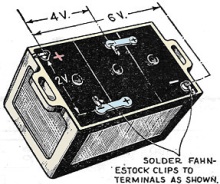 Tapping Storage Battery Tapping Storage Battery
In obtaining different filament on heater voltage for tubes from storage batteries,
I solder Fahne-stock clips on each section of the battery, then I have 2 volts,
4 volts. and 6 volts. When reducing to a fraction of the next voltage, I use a variable
resistor and a voltmeter to obtain the correct voltage. - Walter Rinkowski.
 Handy Test-Prod Handy Test-Prod
A very serviceable test-prod can he made from ice-picks by covering part of the
pick with rubber tubing (see drawing) and by placing rubber spark-plug caps on each
end of the wooden handle. The wire goes in through the top. - Barry Hassink.
 Vernier Regeneration Control Vernier Regeneration Control
For smooth regeneration control on very weak signals the following kink is very
effective: Connect a three-plate midget condenser across the main regeneration control
condenser. With the plates of this vernier condenser unmeshed, tune in a signal
and stop the set from oscillating with the main control. Now, gradually increase
the capacity of the vernier condenser and you will find that the signal can be built
up to a much greater extent than with the ordinary control. - W. Zelezng.
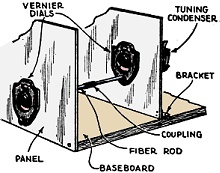 Real Vernier Tuning Real Vernier Tuning
For the radio operators who are having trouble tuning in stations on their vernier
dial, I present the following kink: Take an ordinary vernier dial and remove the
knob. Mount your tuning condenser on a second metal panel about three inches from
the front panel, next, mount a vernier dial with the knob removed on your second
panel with a fiber insulating rod connecting the front vernier dial with the second
one. Place the first knob on the front or your panel and place the second one in
back on a supported metal panel and your "super-vernier" tuner is complete. - Otis
R. Hill. Jr.
Posted February 9, 2024
(updated from original
post on 4/21/2017)
|





















